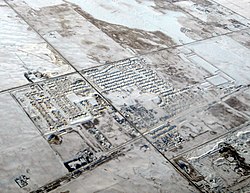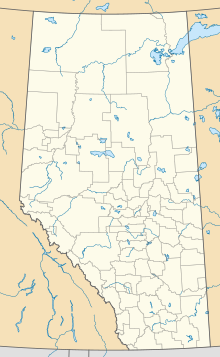Hamlet in Alberta, Canada
| Langdon | |
|---|---|
| Hamlet | |
 Aerial view of Langdon in winter Aerial view of Langdon in winter | |
 | |
| Coordinates: 50°58′21″N 113°40′36″W / 50.97250°N 113.67667°W / 50.97250; -113.67667 | |
| Country | Canada |
| Province | Alberta |
| Census division | No. 6 |
| Municipal district | Rocky View County |
| Incorporated (village) | August 31, 1907 |
| Dissolved | January 1, 1946 |
| Government | |
| • Type | Unincorporated |
| • Reeve | Greg Boehlke |
| • Governing body |
Rocky View County Council
|
| Area | |
| • Land | 9.26 km (3.58 sq mi) |
| Elevation | 1,005 m (3,297 ft) |
| Population | |
| • Total | 5,497 |
| • Density | 593.4/km (1,537/sq mi) |
| Time zone | UTC−7 (MST) |
| • Summer (DST) | UTC−6 (MDT) |
| Area code(s) | 403, 587, 825 |
Langdon is a hamlet in southern Alberta, Canada under the jurisdiction of Rocky View County. It previously held village status between August 31, 1907, and January 1, 1946.
Langdon is located 12 km (7.5 mi) east of the City of Calgary at the intersection of Highway 560 (Glenmore Trail) and Highway 797, approximately 6 km (3.7 mi) south of the Trans Canada Highway and 7 km (4.3 mi) north of Highway 22X. It has an elevation of 1,005 m (3,297 ft).
The hamlet is located in Census Division No. 6 and in the federal riding of Bow River. The hamlet is represented in federal government by Member of Parliament Martin Shields and in municipal government by Councillor Al Schule.
History
Langdon was named for R.B. Langdon of Langdon & Shepard, a Canadian Pacific Railway subcontracting firm who built a section of the line just east of Calgary. He was born in Vermont in 1826 and worked on the railroad lines within at least ten US states, notably the St. Paul & Pacific Railroad in 1858. Langdon was a state senator in Minnesota from 1873 to 1881. The nearby Shepard station was named for his partner. Langdon was one of two people to turn the first sod in the settlement in 1882. A year later, a railway station was set up in a boxcar and named after him.
A post office was established on January 1, 1890, and a telegraph office in 1899. Langdon incorporated as a village on August 31, 1907. It subsequently dissolved on January 1, 1946, to become part of the Municipal District of Conrich No. 44.
Demographics
| Year | Pop. | ±% |
|---|---|---|
| 1911 | 159 | — |
| 1916 | 161 | +1.3% |
| 1921 | 128 | −20.5% |
| 1926 | 94 | −26.6% |
| 1931 | 83 | −11.7% |
| 1936 | 101 | +21.7% |
| 1941 | 95 | −5.9% |
| 1951 | 77 | −18.9% |
| 1956 | 81 | +5.2% |
| 1961 | 98 | +21.0% |
| 1966 | 97 | −1.0% |
| 1971 | 109 | +12.4% |
| 1976 | 141 | +29.4% |
| 1981 | 199 | +41.1% |
| 1986 | 203 | +2.0% |
| 1991 | 279 | +37.4% |
| 1996 | 390 | +39.8% |
| 2001 | 1,685 | +332.1% |
| 2006 | 2,595 | +54.0% |
| 2011 | 4,211 | +62.3% |
| 2016 | 5,305 | +26.0% |
| 2021 | 5,497 | +3.6% |
| Source: Statistics Canada | ||
In the 2021 Census of Population conducted by Statistics Canada, Langdon had a population of 5,497 living in 1,759 of its 1,792 total private dwellings, a change of 3.6% from its 2016 population of 5,305. With a land area of 9.26 km (3.58 sq mi), it had a population density of 593.6/km (1,537.5/sq mi) in 2021.
The population of Langdon according to the 2018 municipal census conducted by Rocky View County is 5,364, a 9.5% increase from its 2013 municipal census population count of 4,897.
As of 2021, Langdon is 94.1% White, and 5.6% a visible minority. More specifically, the population is 29.3% English, 25.3% Scottish, 20.7% German, 19.2% Canadian, 18.2% Irish, and 10.3% Ukrainian. The largest visible minority population is Black, comprising 1.2% of Langdon's population.
40% of Langdon's population is Christian, and 59.3% is irreligious.
Attractions
Langdon is home to The Track - a golf course formerly known as the Boulder Creek Golf Course. To the northwest of Langdon is the wetland waterfowl habitat Weed Lake. Langdon Days is an annual event hosted in the town during the summer baseball season and includes a parade down main street and a lot of good advertising for small businesses in the town.
Education
Langdon School provides education to students in kindergarten through grade 9. Sarah Thompson School provides education to students from K-5. The Langdon high school is still in development but is set to open for the 2024-2025 school year.
See also
- List of communities in Alberta
- List of designated places in Alberta
- List of former urban municipalities in Alberta
- List of hamlets in Alberta
References
- ^ "The Alberta Gazette, 1907: Establishment of Villages". Government of Alberta. September 30, 1907. p. 8. Retrieved September 27, 2015.
- ^ "The Alberta Gazette, 1946: Dissolution of the Village of Langdon and the Lands Added to the Municipal District of Conrich No. 44". Government of Alberta. January 15, 1946. p. 44. Retrieved September 27, 2015.
- ^ "Population and dwelling counts: Canada and designated places". Statistics Canada. February 9, 2022. Retrieved February 10, 2022.
- "Specialized and Rural Municipalities and Their Communities" (PDF). Alberta Municipal Affairs. April 1, 2010. Archived from the original (PDF) on February 29, 2012. Retrieved June 6, 2010.
- Langdon Crossings Archived 2006-03-08 at the Wayback Machine
- Folsom, William Henry Carman (January 1888). Fifty Years In The Northwest: With An Introduction And Appendix Containing Reminiscences, Incidents, And Notes. Pioneer Press Co. p. 529. Retrieved February 25, 2012.
R.B. Langdon.
- Read, Tracey (1983). Acres and Empires – A History of the Municipal District of Rocky View, Calgary, Alberta.
- Read, Tracy (1983). Acres and Empires : A History of the Municipal District of Rocky View No. 44. p. 83.
- Fifth Census of Canada, 1911 (PDF). Vol. Special Report on Area and Population. Dominion Bureau of Statistics. February 27, 1912. Retrieved November 29, 2021.
- 1916 Census of Prairie Provinces (PDF). Vol. Population and Agriculture. Dominion Bureau of Statistics. January 12, 1918. Retrieved December 1, 2021.
- "Table 6: Population of census subdivisions, 1926-1946". 1946 Census of Alberta (PDF). Vol. Population. Ottawa: Dominion Bureau of Statistics. August 22, 1949. Retrieved December 1, 2021.
- "Table 6: Population by census subdivisions, 1901–1961". 1961 Census of Canada (PDF). Series 1.1: Historical, 1901–1961. Vol. I: Population. Ottawa: Dominion Bureau of Statistics. March 8, 1963. Retrieved December 1, 2021.
- Ninth Census of Canada, 1951 (PDF). Vol. SP-7 (Population: Unincorporated villages and hamlets). Dominion Bureau of Statistics. March 31, 1954. Retrieved November 29, 2021.
- Census of Canada, 1956 (PDF). Vol. Population of unincorporated villages and settlements. Dominion Bureau of Statistics. October 25, 1957. Retrieved November 29, 2021.
- "Population of unincorporated places of 50 persons and over, Alberta, 1961 and 1956". 1961 Census of Canada: Population (PDF). Series SP: Unincorporated Villages. Vol. Bulletin SP—4. Ottawa: Dominion Bureau of Statistics. April 18, 1963. Retrieved November 29, 2021.
- "Population of unincorporated places of 50 persons and over, 1966 and 1961 (Alberta)". Census of Canada 1966: Population (PDF). Special Bulletin: Unincorporated Places. Vol. Bulletin S–3. Ottawa: Dominion Bureau of Statistics. August 1968. Retrieved November 29, 2021.
- "Population of Unincorporated Places of 50 persons and over, 1971 and 1966 (Alberta)". 1971 Census of Canada: Population (PDF). Special Bulletin: Unincorporated Settlements. Vol. Bulletin SP—1. Ottawa: Statistics Canada. March 1973. Retrieved November 29, 2021.
- "Geographical Identification and Population for Unincorporated Places of 25 persons and over, 1971 and 1976". 1976 Census of Canada (PDF). Supplementary Bulletins: Geographic and Demographic (Population of Unincorporated Places—Canada). Vol. Bulletin 8SG.1. Ottawa: Statistics Canada. May 1978. Retrieved November 29, 2021.
- 1981 Census of Canada (PDF). Place name reference list. Vol. Western provinces and the Territories. Ottawa: Statistics Canada. May 1983. Retrieved November 29, 2021.
- Census Canada 1986: Population (PDF). Alberta: Population and Dwelling Counts – Provinces and Territories. Statistics Canada. June 1977. pp. 12–1 to 12–2. Retrieved November 29, 2021.
- "Table 16: Population and Dwelling Counts, for Urban Areas, 1991 and 1996 Censuses – 100% Data". 96 Canada (PDF). A National Overview: Population and Dwelling Counts. Ottawa: Statistics Canada. April 1997. pp. 184–198. Retrieved November 29, 2021.
- "Population and Dwelling Counts, for Canada, Provinces and Territories, and Census Divisions, 2001 and 1996 Censuses - 100% Data (Alberta)". Statistics Canada. August 15, 2012. Retrieved November 29, 2021.
- "Population and dwelling counts, for Canada, provinces and territories, and urban areas, 2006 and 2001 censuses - 100% data (Alberta)". Statistics Canada. July 20, 2021. Retrieved December 1, 2021.
- "Population and dwelling counts, for Canada, provinces and territories, and designated places, 2006 and 2001 censuses - 100% data (Alberta)". Statistics Canada. July 20, 2021. Retrieved December 1, 2021.
- "2016 Census of Population: Hamlet of Clairmont" (PDF). Alberta Population. February 20, 2017. Retrieved December 5, 2021.
- "2018 County Census". Rocky View County.
- "County Census Identifies Divisional Population Changes". Rocky View County. September 23, 2013. Retrieved September 23, 2013.
- ^ Government of Canada, Statistics Canada (February 9, 2022). "Profile table, Census Profile, 2021 Census of Population - Langdon, Unincorporated place (UNP) [Designated place], Alberta". www12.statcan.gc.ca. Retrieved June 7, 2024.
- "The Track Langdon". The Track Golf Course. Retrieved February 7, 2023.
- "Langdon School". Rocky View Schools. Retrieved February 24, 2012.
- "Sarah Thompson School (K-5) — Rocky View Schools". www.rockyview.ab.ca. Retrieved April 11, 2018.
- Karamitsanis, Aphrodite (1992). Place Names of Alberta – Volume II, Southern Alberta, University of Calgary Press, Calgary, Alberta.
External links
| Places adjacent to Langdon, Alberta | ||||||||||||||||
|---|---|---|---|---|---|---|---|---|---|---|---|---|---|---|---|---|
| ||||||||||||||||